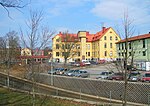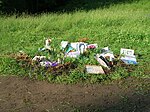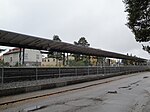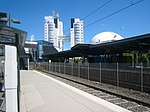Saint Sava Serbian Orthodox Church, Stockholm
1991 establishments in Sweden20th-century churches in SwedenCathedrals in SwedenChurch buildings with domesChurches completed in 1991 ... and 3 more
Churches in StockholmSerbian Orthodox cathedralsSerbian Orthodox church buildings in Sweden

The Saint Sava Serbian Orthodox Church (Swedish: Sankt Sava serbisk-ortodoxa kyrka; Serbian: Црква светог Саве, Crkva svetog Save) is a church building in Enskede gård in Stockholm, Sweden. It was taken into use in 1991 but not officially inaugurated until 5 October 2014. It is the cathedral church of the Serbian Orthodox Eparchy of Britain and Scandinavia.
Excerpt from the Wikipedia article Saint Sava Serbian Orthodox Church, Stockholm (License: CC BY-SA 3.0, Authors, Images).Saint Sava Serbian Orthodox Church, Stockholm
Bägerstavägen, Stockholm Enskede gård (Enskede-Årsta-Vantörs stadsdelsområde)
Geographical coordinates (GPS) Address Nearby Places Show on map
Geographical coordinates (GPS)
| Latitude | Longitude |
|---|---|
| N 59.2894 ° | E 18.0617 ° |
Address
S:t Sava serbiskortodoxa kyrkan
Bägerstavägen 68
120 47 Stockholm, Enskede gård (Enskede-Årsta-Vantörs stadsdelsområde)
Sweden
Open on Google Maps











